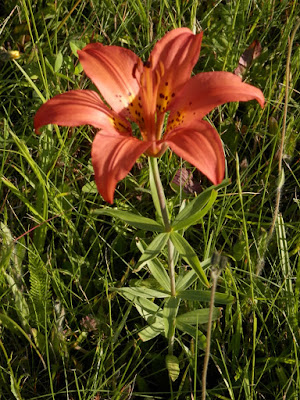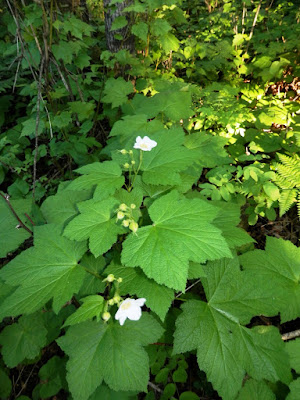 |
| A mature white pine on our acreage. Deer eat all the seedlings. |
She wanted to talk to people who have spent most of their lives outdoors in Northwestern Ontario to see how climate change is affecting them. If you go to her website you can read excerpts from her interviews including ours.
Most of us are saddened, anxious and even depressed by what is happening although a few see opportunities from it. There are realities, however, that temper what seem like advantages from climate change in Northwestern Ontario. For instance you might think that warmer temperatures and a longer growing season would see this area become an agricultural powerhouse. There is a bit of farming here now but it is limited primarily to hay and potatoes. One enormous reason why this region is not ever going to take over as the Breadbasket for North America is a lack of soil.
Glaciers in the last Ice Age sent all of ours to the U.S. Midwest. The only soil that we have is clay, and it exists only in tiny pockets around Thunder Bay, Dryden, Rainy River and Fort Frances. Everything else is sand, gravel and peat.
My observation is that there are a cascade of effects happening from climate change, most of them not obvious to casual observers. To illustrate, I'll just pick one, the emergence of whitetail deer as the primary wild herbivore. In my lifetime I have seen the disappearance of woodland caribou, the emergence and then the decline of moose and now the dominance of whitetail deer. Logging was undoubtedly the primary reason for the disappearance of caribou and the emergence of moose but climate change is behind the explosion in deer numbers.
Our famous Boreal Forest winters simply don't exist any more. More important than warm temperatures, as far as deer are concerned, is the lack of snowfall. Back in the '60s there were quite a few deer in Red Lake, lured to the area by logging that produced lots of hardwood browse in cutovers. It was excellent for moose for the same reason. Then we had several consecutive winters with over four feet of snow. Deer were absolutely wiped out except for pockets at Thunder Bay, Dryden, Fort Frances and Rainy River where agriculture sustained them. Moose, on the other hand, have much longer legs and although hampered by the deep snow, are not killed by it. So deer disappeared and moose took off.
Now the snow comes late, leaves early and never amounts to more than two feet. The deer have come back big-time. Red Lake is one of the few places where they still are scarce, just because it is so far from the main deer concentrations farther south, but even there the population is re-building fast. You see them especially in the town of Red Lake.
And moose are disappearing. Deer carry a brain worm parasite that is harmless to them but fatal to moose. The parasite spreads quickly and easily. No sooner do you notice equal numbers of deer and moose than there are no moose at all.
At our home in Nolalu, 48 kilometers southwest of Thunder Bay, moose are gone and the deer population is sky high. It has been that way for decades.
Deer also bring with them ticks. When we raised our sons here in the 1980s and '90s not once did they have a tick on them. Now you can pick up several ticks just walking across the yard. Red Lake is mostly tick-free so far.
The deer are also changing the vegetation. We attended a climate change conference in Thunder Bay a few years ago where it was predicted that this area will become an oak savanna due to warmer temperatures. It is currently right on the edge of the Boreal Forest. The closest oak forests are on the other side of Lake Superior in Wisconsin. Oaks spread faster than other trees, it was noted, because blue jays and animals carry away their acorns.
What wasn't predicted was the rapid demise of native tree species, just from heavy browsing by deer. They eat 100 per cent of the seedlings of white pine, red pine and jackpine as well as those of white cedar and red maple. I mean, they get every one. On our 65 acres there are no trees of those species younger than 15 years old. What is left are balsam fir, black spruce and white spruce, quaking aspen, balsam poplar and white birch.
Balsam fir is a prolific seeder and it is not hard to see that in the future we are going to have large stands of them throughout the Thunder Bay area. Balsam is affected about every 40 years by a pest called the spruce budworm that ends up killing them all. This leaves large acreages of standing dead trees that are among the most volatile when it comes to forest fires. At first this may seem like nothing new because the balsam-budworm-fire cycle has been going on forever. What will be different is just the sheer size of the fires. We can expect lots of towns to be threatened.
And incredibly, this will have been initiated by the deer, just because they ate competing tree species for balsam.
The deer are likely extirpating smaller plants too, such as wildflowers, but it isn't as obvious.
So we don't have to wait for blue jays to bring oaks to the North. The forest is changing right now.
And that is just the result of one new species entering the ecosystem due to climate change.
Of course, there are also going to be wholesale changes just from the weather. Colossal rain events that are happening all over the world now are going to reshape the landscape in a hurry.
They are also going to cause major upheavals in our transportation system. Here in Nolalu we have had two unbelievable storms in the past few years that have devastated the road network. Road crews right now are installing more and bigger culverts everywhere to hopefully reduce the problem in the future but how successful their efforts will be is unknown.
As some of Kelsey's interviewees point out, weather events now are unpredictable. We can stop using terms like "100-year storm" and "500-year storm" because the new rainfalls are unprecedented.
Brenda remains optimistic, as do some of the others. We will adapt, she says, and undoubtedly we will. There is no other choice.
What I find particularly sad about the whole situation is that the means to lessen the effects of climate change are right in our hands, yet so few people are participating, at least at the national level. Individually and locally it is a different story and that is where hope really lies. The problem is we are out of time for everything except making a bad situation even worse
Click to see the latest on the blog


























